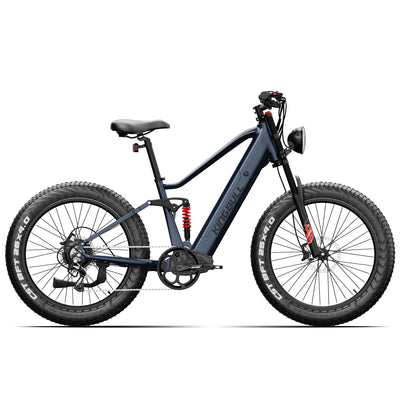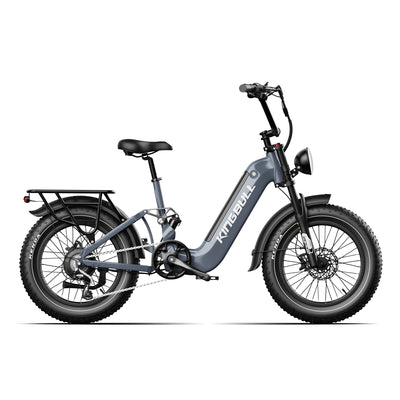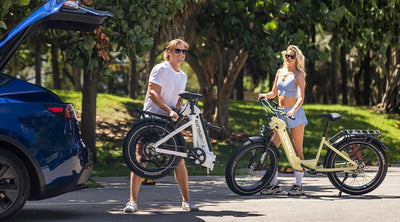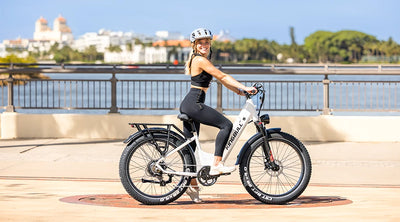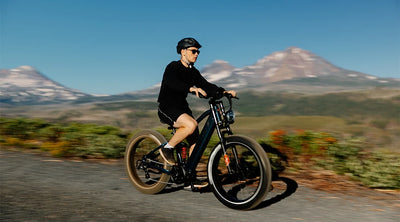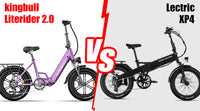Explore News

Tips & Cycling Knowledge
How to Remove the Speed Limit on an Electric Bike
Speed limit is a feature built into electric bikes that is designed to limit the maximum speed of the electric bike.Typically, the controller on an electric bike is equipped with a speed limiter, which limits the motor power to ensure that the speed of the electric bike is controlled within the allowed range. In the United States, the speed of electric bikes is usually controlled at 20-28mph.
Why Do Electric Bikes Need Speed Limiters?
Almost every electric bike is equipped with a speed limiter to ensure the safety of the rider and comply with local laws. The functions of the speed limiter usually include:
Improve safety: Like motorcycles, electric bicycles have an increased chance of traffic accidents when they are too fast. By limiting the maximum speed of electric bicycles, the risk of accidents can be greatly reduced.
Legal compliance: In the United States, the maximum speed limit for electric bicycles in most areas does not exceed 28mph. The speed limiter can ensure that you comply with local traffic laws when riding.
Extended service life: By limiting motor power, you can extend the service life of the battery, motor, and even the tires.
Therefore, the installation of a speed limiter is necessary. It not only protects your riding safety, but also effectively extends the service life of your electric bicycle.
Why Remove Speed Limiters?
We have received some inquiries from customers about how to remove speed restrictions. For some personal reasons, some people may need to remove speed restrictions.
Increased speed: Some riders seek out higher speeds, and by removing the speed limit, e-bikes can reach speeds of 40mph or even 50mph, providing a faster riding experience.
Save time: Due to long-distance commuting or outdoor riding needs, faster speed can save more time.
Bicycle modification: Some riders like to modify their bicycles, and adjusting the speed of the bicycle is one of the very common modification projects.
It is common to remove speed limiters to lift speed restrictions, but you still need to be aware that removing speed limits brings some risks.
Safety risks: After the speed limit is lifted, electric bicycles will travel too fast, which will increase the risk of traffic accidents.
Legal issues: You can still face prosecution for speeding above local laws.
Reduced device life: The motor power limit has been removed, which will affect the life of the battery, motor, and some other parts.
Warranty Policy: The merchant’s warranty policy will not cover problems caused by illegal modifications, including lifting speed limits.
Bike damage: If you don’t do the right operation, your e-bike may malfunction, both in the controller and the motor.
If you still need to consider lifting the speed limit, we recommend that you first ask the original seller. At the same time, you should also consider the above problems that may occur after lifting the speed limit.
How To Remove The Speed Limit On Electric Bikes?
If you need to remove the speed limit, you first need to ask the original seller whether the bicycle's display and controls retain the function of removing the speed limit. If the original seller retains the function of removing the speed limit, you do not need to take any further action.
Here are the steps to remove the speed limiter:
Power off: Make sure your e-bike is off. Remove the battery if it is removable.Locate the controller: This is usually located behind the battery, in the center bottom of the bike.Locate the speed limiter: The speed limiter is usually attached to the controller. Different devices and brands use different speed limiters, you can ask the original seller.Remove the speed limiter: Disconnect the speed limiter from the controller. If the speed limiter is programmed, it is usually not possible for the user to remove the speed limit.Test the bike: Once you have completed all the work, you need to test the bike to see if the speed limit is removed and if it is working properly. Be sure to test it in a safe road environment.Kingbull does not recommend that any user remove the speed limit on an e-bike if it is not necessary. This is not only illegal, but also increases the risk of accidents.
Other Ways to Increase Speed on an E-Bike
We don't recommend anyone to remove the speed limit of an electric bike, but there are some correct ways to increase the speed of your electric bike.Battery power: Keep the battery fully charged, the voltage of the battery will affect the speed of the electric bikeChange tires: Change to tires with less resistance, such as urban tires.Riding posture: Adopt a leaning riding posture to reduce wind resistance, which can also increase your riding speed.
Speed Upgrade Controller: This is typically used for e-bikes equipped with factory-programmed speed-limited controllers that cannot be unlocked. By replacing it with a compatible new controller, you can achieve higher speed performance.
Conclusion
Removing the speed limit on an e-bike does allow you to experience faster speeds and enjoy a more exciting riding experience, but it also comes with many risks.Kingbull's e-bikes offer a maximum speed of 28mph, which can meet the riding needs of most people, combining speed and safety, and complying with legal regulations.Before making any modifications, please consider the potential risks and try other options to increase the speed of the bike. For example, replace the battery, tires, etc.
Read more

Tips & Cycling Knowledge
Electric Bike Charging Guide: Safe and Effective Charging Tips and Best Practices
Electric bikes (e-bikes) have become an increasingly popular mode of transportation, offering an eco-friendly and convenient way to travel. However, to keep your e-bike running smoothly and ensure its longevity, it's essential to know how to charge it correctly. In this guide, we’ll cover everything you need to know about charging your electric bike safely and effectively.
Understanding Your E-Bike Battery
Before diving into the charging process, it’s important to familiarize yourself with your e-bike’s battery type and specifications. Most e-bikes use lithium-ion (Li-ion) batteries due to their high energy density, long lifespan, and relatively light weight. These batteries typically last between 3 to 5 years, depending on usage and care. You can click here to view information about battery longevity of Kingbull electric bikes.
Key Points to Consider:
Battery Capacity: Measured in watt-hours (Wh), it determines how far you can ride on a single charge.
Voltage: Indicates the power level; common e-bike batteries range from 36V to 48V.
Charging Time: Depending on the battery’s capacity and the charger’s output, charging can take anywhere from 3 to 7 hours.
You can click here to view battery information for each Kingbull electric bike model.
How to Properly Charge Your Kingbull Electric Bike
We have received feedback from many customers regarding issues with charging their Kingbull electric bikes. In the following sections, we will guide you on how to properly charge your Kingbull electric bike. There are two main methods of charging: one involves removing the battery from the bike to charge it separately, and the other involves charging the battery directly while it remains on the bike.
Method 1: Charging the Battery Off the Bike
Remove the Battery
Start by carefully removing the battery from the bike. Make sure the bike is turned off before doing this. Kingbull electric bikes have a key allows you to safely detach the battery.
Connect the Charger
Once the battery is removed, connect the charger to the battery’s charging port. Ensure the connection is secure.
Plug in the Charger
Plug the charger into a power outlet. The charger’s indicator light will usually turn red to show that charging is in progress. Once the battery is fully charged, the light will typically turn green.
Reattach the Battery
After the battery is fully charged, disconnect the charger, and carefully reattach the battery to the bike, making sure it’s securely locked in place.
Method 2: Charging the Battery On the Bike
Make sure the power is turned off before charging. It should be noted that our electric bike cannot be started during the charging process. Therefore, when you complete charging, you need to unplug the charger before you can start the electric bike.
Locate the Charging Port
If you prefer to charge the battery while it is still mounted on the bike, locate the charging port on your Kingbull electric bike. The charging port is located on the right side of the battery. You will need to open the rubber cover to access the charging port.
Connect the Charger
Connect the charger to the battery’s charging port on the bike. Make sure the connection is tight and secure to prevent any interruptions during the charging process.
Plug in the Charger
Plug the charger into a power outlet. The indicator light on the charger should turn red to indicate that charging is in progress. When the battery is fully charged, the light will turn green.
Monitor the Charging Process
During charging, it’s recommended to periodically check the charger and the bike to ensure everything is functioning correctly. Once the battery is fully charged, unplug the charger.
Why Does the Charger Make Noise During Charging
Hearing a noise from the charger while it’s plugged in and charging your Kingbull electric bike is usually normal and not a cause for concern.
Kingbull electric bike chargers are equipped with a cooling fan to prevent the charger from overheating during the charging process. When the charger is actively working, the fan may turn on to regulate the temperature, which can produce a soft whirring or humming noise. This is a standard feature designed to protect the charger and your battery from heat damage.
Conclusion
Properly charging your electric bike is crucial for ensuring a long battery life and maintaining optimal performance. By following these tips and best practices, you can charge your e-bike safely and effectively, helping you enjoy many more miles of smooth, eco-friendly rides.
If you have any questions, you can contact us via email customers@kingbullbike.com.
Happy riding!
Read more
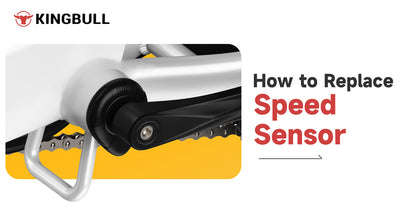
MaintenanceTips & Cycling Knowledge
How to Replace the Speed Sensor on Your Electric Bike: A Step-by-Step Guide
If your electric bike’s speed isn’t showing correctly, the speed sensor might need to be replaced. Luckily, it’s a simple fix you can do yourself with the right tools and a little patience. Here's a quick guide to help you replace it.
Tools You’ll Need
Before you get started, make sure you have the following tools and materials handy:
Hex key
Multi-tool
Crank removal tool
A new speed sensor
Safety Precautions
Disconnect the electric bike’s power to avoid any accidents during the process.
1. Removing the Crank
Step 1: Use the appropriate tool to loosen and remove the bolt securing the crank.
Step 2: Attach the crank removal tool to the crank. Turn the tool clockwise using a hex key until the crank loosens, and then remove it.
2. Removing the Old Speed Sensor
Step 3: Locate the old speed sensor near the crank. It’s usually connected to the controller with a cable.
Step 4: Carefully disconnect the sensor from the controller. Avoid pulling on the cable to prevent damage.
Step 5: Remove the old speed sensor from its position.
3. Installing the New Speed Sensor
Step 6: Place the new speed sensor in the same location as the old one.
Step 7: Reconnect the sensor’s cable to the controller, making sure the connection is secure.
Step 8: Check that the new sensor is properly aligned and won’t rub against the crank or other parts.
4. Reinstalling the Crank
Step 9: Reinstall the crank onto the bike, making sure it’s positioned correctly.
Step 10: Use the multi-tool to securely tighten the bolt that holds the crank in place.
5. Testing the Speed Sensor
Step 11: Reconnect the bike’s power and turn it on.
Step 12: Test the sensor by lifting the rear wheel off the ground and manually rotating the pedals. Check to see if the speed reading is accurate.
6. Troubleshooting
If the speed sensor doesn’t work correctly:
Check the cable connection to ensure it’s tight.
Try recalibrating the sensor.
Wrapping It Up
And that’s it! By following these simple steps, you can replace your electric bike’s speed sensor and get back to enjoying smooth rides with accurate speed readings.If you are unsure or have issues, please feel free to contact kingbull for further assistance.
Read more

Tips & Cycling Knowledge
The Secret to Smoother Rides: Understanding Electric Bike Suspension Systems
If you're into electric bikes or just getting started, you've probably wondered: why do some bikes feel like you're floating on air while others make you feel every bump in the road? The secret lies in the suspension system—the unsung hero of a smooth ride. Today, we're going to break down what you need to know about electric bike suspension systems, the different types, how to choose the right one for your ride, and some tips to keep things running smoothly.
What’s a Suspension System Anyway?
Simply put, a suspension system is your bike’s shock absorber. When you hit bumps, potholes, or rough terrain, the suspension takes the hit so you don't have to. Instead of every jolt being passed up to your hands, arms, and back, the suspension helps cushion the blow, making your ride feel a lot smoother.
There are two main types of suspension you'll find on electric bikes:
Front Suspension (Fork Suspension): This is the most common type and is installed on the front wheel. Since most of the bumps hit your bike from the front, a good front suspension helps keep the ride comfortable by absorbing shocks before they reach your handlebars. A solid front suspension means your arms won't feel like they've done a workout after every ride!
Rear Suspension: You’ll find rear suspension on more rugged, off-road electric bikes. If you're the kind of person who loves the thrill of tackling mountain trails or bumpy backroads, rear suspension keeps the back half of your bike steady and helps you stay in control no matter how rough the terrain gets.
Types of Suspension: Spring vs. Hydraulic
Now, not all suspension systems are created equal. The two big players in the suspension game are spring suspension and hydraulic suspension. They both absorb shocks, but they do it a little differently.
Spring Suspension: This is the old-school kind, using metal springs to take the brunt of the impact. It’s reliable and durable, but sometimes it can feel a bit stiff, especially when you hit larger bumps. You’ll notice the difference, but it might not completely erase the jolt.
Hydraulic Suspension: This is where things get fancy. Hydraulic suspension uses compressed fluid to cushion the ride, giving you a smoother and more responsive experience. It's like the luxury version of suspension—soft, controlled, and perfect for riders who crave comfort across all terrains. Riding a bike with hydraulic suspension feels more like driving a cushy SUV than a bumpy bicycle.
Tips for Choosing the Right Suspension
When it comes to choosing the right suspension for your electric bike, it’s all about matching it to your riding style. Here are a few quick tips:
For City Commuters: If you're mostly cruising through city streets, a good front suspension will do the trick. It’ll help you glide over cracks, potholes, and speed bumps without feeling like you're riding a jackhammer. Luckily, all Kingbull electric bikes come equipped with high-performance front suspensions, ensuring a smooth and comfy ride no matter what the city throws at you.
For Off-Road Adventurers: If your idea of fun involves taking on rough trails, rocky paths, or sandy beaches, then a front and rear suspension combo is your best bet. This setup gives you the balance and control you need for tackling unpredictable terrain without losing your cool. Our Kingbull Rover off-road electric bike, for example, comes with both front and rear suspension, so you’re ready for anything—from mountain biking to beach riding.
Is Hydraulic Suspension Worth It?: If you’re serious about comfort or plan to ride on a variety of surfaces, hydraulic suspension is worth every penny. The hydraulic front suspension in Kingbull electric bikes delivers a silky-smooth ride—whether you're commuting or exploring off the beaten path. While it costs a bit more, the performance boost and durability make it an investment that pays off with every ride.
Maintenance Tips for Your Suspension
Your bike’s suspension system might not get as much attention as other parts, but it works hard to keep you comfortable. Here are some quick tips to keep your suspension in tip-top shape:
Keep It Clean: Dirt and mud can get into your suspension and cause it to wear down faster. If you're riding through muddy areas, give your bike a quick wash afterward, especially around the suspension.
Regular Checkups: Every few months, check how your suspension is performing. Listen for any strange noises, and pay attention to whether it feels less smooth than usual. If it seems stiff or sluggish, it might be time for some maintenance or a fluid change.
Don’t Overload It: Your suspension system has a weight limit, so be careful not to overload your bike, especially on rough rides. Too much weight can wear out your suspension faster and lead to a less comfortable ride.
The Bottom Line
A good suspension system can make all the difference between a bumpy, uncomfortable ride and a smooth, enjoyable one. Whether you're zipping through city streets or tearing up off-road trails, choosing the right suspension for your electric bike is key to making sure every ride feels like a dream. Kingbull electric bikes are equipped with high-quality hydraulic front suspensions across the board, and if you're after the ultimate off-road experience, our Rover model delivers with front and rear suspension, giving you unbeatable control and comfort on any terrain.
So, the next time you're out riding, take a moment to appreciate your suspension system—it’s the secret sauce to a smooth, effortless ride!
Read more

Tips & Cycling Knowledge
Discover the Best Electric-Powered Campsites in the USA
Planning your next camping adventure and want to ensure you have access to electric power? Whether you're charging your electric bike, keeping your gadgets powered up, or simply enjoying the convenience of modern amenities, we've got you covered. Here’s your ultimate guide to the best electric-powered campsites in the USA, guaranteeing a memorable and hassle-free outdoor experience.
1. Yosemite National Park, California
North Pines Campground
Yosemite National Park is a paradise for nature lovers, and North Pines Campground is perfect for those seeking electric hook-ups. Nestled among towering pines, this campground offers stunning views and easy access to the Merced River. Electric sites are limited, so book early!
Amenities:
Electric hook-ups
Drinking water
Restrooms
Picnic tables and fire rings
Highlights:
Scenic river views
Proximity to Yosemite Valley attractions
Ample hiking and biking trails
2. Zion National Park, Utah
Watchman Campground
Located near the park's south entrance, Watchman Campground provides electric hook-ups in a picturesque setting. With the iconic Zion Canyon as your backdrop, this campground is ideal for exploring the park's renowned trails and enjoying star-filled nights.
Amenities:
Electric hook-ups
Drinking water
Restrooms and showers
Picnic tables and fire rings
Highlights:
Electric hook-ups available
Easy access to Zion Canyon
Shuttle service to major trailheads
3. Great Smoky Mountains National Park, Tennessee/North Carolina
Elkmont Campground
Elkmont Campground is a fantastic option for those visiting the Great Smoky Mountains. This campground offers a mix of electric and non-electric sites, ensuring you stay connected while immersing yourself in the park's rich biodiversity.
Amenities:
Electric hook-ups
Drinking water
Restrooms
Picnic tables and fire rings
Seasonal on-site store
Highlights:
Electric hook-ups available
Historic sites within the campground
Close to Cades Cove and Clingmans Dome
4. Acadia National Park, Maine
Blackwoods Campground
Blackwoods Campground is your gateway to the rugged beauty of Acadia National Park. While the campground itself doesn't offer electric hook-ups, it provides easy access to nearby RV parks with full amenities, ensuring you can recharge and relax after a day of exploring.
Amenities:
Drinking water
Restrooms and showers
Picnic tables and fire rings
Trash disposal facilities
Highlights:
Proximity to Bar Harbor and Cadillac Mountain
Beautiful coastal scenery
Access to hiking and biking trails
5. Glacier National Park, Montana
Fish Creek Campground
Fish Creek Campground is a serene spot located on the west side of Glacier National Park. This campground offers electric hook-ups and is perfect for those who want to explore the park's stunning landscapes without sacrificing modern conveniences.
Amenities:
Electric hook-ups
Drinking water
Restrooms and showers
Picnic tables and fire rings
Trash disposal facilities
Highlights:
Electric hook-ups available
Close to Lake McDonald
Access to the Going-to-the-Sun Road
Tips for Camping with Electric Bikes
Bringing your electric bike on a camping trip adds a whole new level of fun and convenience. Here are some tips to make the most of your electric bike while camping:
Plan Your Charging: Ensure your campsite has electric hook-ups or nearby charging stations. Portable solar chargers can be a great backup.
Pack Essentials: Bring a sturdy bike lock, helmet, and any necessary repair tools. A small portable pump can be handy for quick tire adjustments.
Explore Local Trails: Many national parks and campgrounds offer fantastic biking trails. Research ahead to find the best routes and scenic spots.
Stay Safe: Always follow park rules and guidelines, wear reflective gear if riding at dusk or dawn, and carry a map or GPS device.
Conclusion
Exploring the great outdoors doesn't mean you have to leave behind the comforts of modern technology. These top electric-powered campsites in the USA offer the perfect blend of nature and convenience, ensuring you have a memorable camping experience. So pack your gear, charge up your electric bike, and get ready for an adventure of a lifetime!
For more tips and guides on camping and electric bikes, subscribe to our newsletter and stay updated with the latest from the world of outdoor adventures. Happy camping!
Read more

Tips & Cycling Knowledge
Ebike Safety Tips: Staying Safe on City Streets
Riding an ebike can be a fun and efficient way to get around, but it's important to prioritize safety. Here are some essential tips to help you stay safe while navigating city streets.
Understanding Local Regulations
Before you hit the road, make sure you understand the specific rules and regulations in your city. While there can be variations, some common regulations include:
Yield to Pedestrians: Always give the right-of-way to pedestrians, especially in crosswalks.
Avoid Sidewalks: Riding on sidewalks can be dangerous for both you and pedestrians.
Ride with the Flow of Traffic: Always ride in the same direction as vehicular traffic. Riding against traffic is extremely dangerous.
Signal Your Intentions: Use hand signals to indicate when you plan to turn or stop. This helps other road users anticipate your movements.
Stay in Designated Bike Lanes: If there's a designated bike lane, use it. If not, ride as far to the right as is safe, but avoid the door zone of parked cars.
Wear a Helmet: Always wear a properly fitted helmet to protect your head in case of a fall.
Obey Traffic Signals and Signs: Treat stop signs and red lights just like you would in a car.
Use Lights at Night: Equip your ebike with front and rear lights and use them whenever visibility is reduced.
Additional Safety Tips
Be Visible: Wear bright-colored clothing and reflective gear, especially at night or in low-light conditions.
Check Your eBike Regularly: Ensure your tires are properly inflated, brakes are working, and lights are functioning.
Be Aware of Your Surroundings: Scan your surroundings constantly, and be prepared to react to unexpected situations.
Ride Defensively: Assume that other road users may not see you. Give yourself plenty of space and avoid taking unnecessary risks.
Obey Speed Limits: While ebikes can go fast, it's important to obey speed limits and ride at a safe speed for the conditions.
Tips for Sharing the Road
Maintain a Safe Following Distance: Leave plenty of space between yourself and other vehicles.
Be Predictable: Ride in a straight line and avoid weaving in and out of traffic.
Use Your Bell: Use your bike bell to alert pedestrians and other cyclists of your presence.
Be Courteous: Show respect for other road users, and they'll be more likely to respect you.
By following these tips, you can enjoy a safe and enjoyable ebike riding experience. Remember, safety should always be your top priority.
Read more




